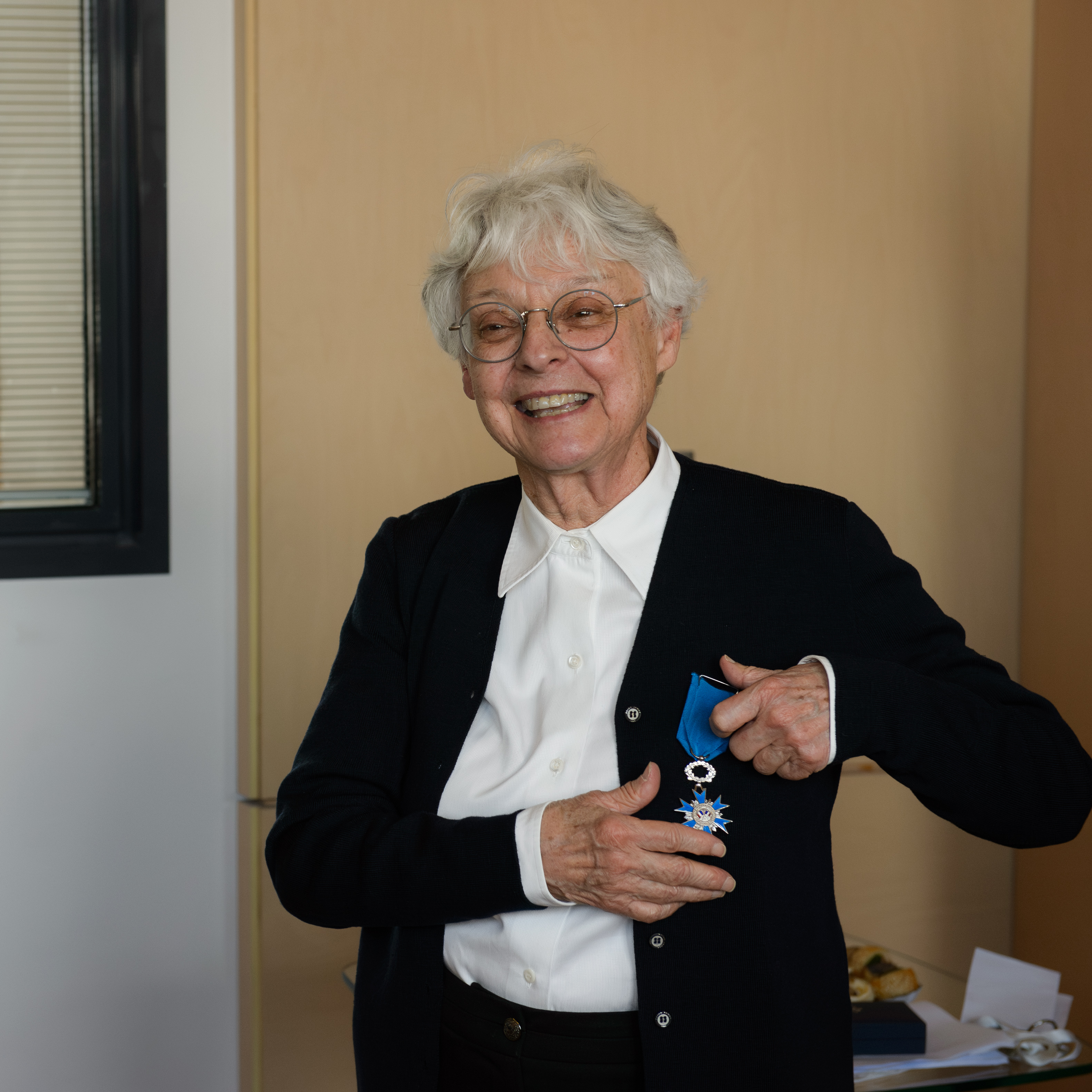MICHÈLE GERBALDI AWARDED CHEVALIER OF THE NATIONAL ORDER OF MERIT
Our colleague Michèle Gerbaldi has been awarded Chevalier of the National Order of Merit for her 39 years of service as a volunteer astrophysicist with astronomy organizations, according to a decree dated January 15, 2025. Congratulations!
Transcript of speech by Alain Omont, CNRS research director emeritus at IAP, Chevalier in the national order of the Legion of Honor, at the award ceremony:

Figure 1: Michèle Gerbaldi, March 26, 2025, at the IAP.
Credit: Jean Mouette (IAP)
Dear Michèle, it gives me great pleasure to recall your long career in astronomy and your involvement in its worldwide dissemination, within the framework of the IAP where you have been based for almost 60 years. This activity, dominated by a communicative passion for astronomy, is naturally divided into three parts: research into the physics and observation of the stars; some forty years of teaching at the University of Orsay, with a focus on teacher training; and above all, a leading role in the IAU's activities to develop astronomy in developing countries.
Your passion for astronomy dates back to childhood. After graduating with a degree in mathematics, you were recruited in 1966 as an assistant at the young Orsay faculty by V. Kourganoff. You arrived at the IAP in 1967 for E. Schatzman's DEA (post-graduate diploma) in astrophysics, and he himself directed your DEA course on stellar physics. Your state thesis (1977), supervised by Nina Morguleff, heroine of the resistance, was part of the great IAP tradition of stellar classification by D. Chalonge, D. Barbier and L. Divan. This enormous work covers 6,700 Am and Ap stars. Today, with Gaia observing billions of stars, it's worth remembering that in the not-too-distant past, observing a few thousand stars took several years, and classifying them meant looking in detail at each object separately. Using observations at OHP and ESO-La Silla, UV data from IUE and distances from Hipparcos, your research, together with your main collaborators N. Morguleff and R. Ferraggiana, has enabled us to gain an in-depth understanding of various particular classes of stars (Ap, Am and λ Bootis), with the influence of metallicity, magnetic field and binarity. The international importance of this work is attested by your chairmanship of IAU Commission 45, “Stellar Classification” from 1997 to 2000, during which the IAU extended stellar classification to brown dwarfs with the definition of the new L and T classes.
As a teacher at Orsay, the most salient point is your involvement over more than 35 years in training secondary and primary school teachers and supporting their teaching of astronomy, in particular through the dissemination of slides of astronomical images (at the instigation of E. Schatzman, with the support of UNESCO) and the installation of a dome and telescopes. You ran two distance learning courses with the CNED, which ran from 1992 to 2006 with hundreds of students. With colleagues, you created the CLEA (Comité de Liaison Enseignants et Astronomes), which focuses its activities on initial and in-service teacher training. This remarkable institution and its publication, Les Cahiers Clairault, are still going strong after more than 50 years.
But, as Diana Worrall has said, it's within the international framework of the IAU that your work has had the greatest impact, as recognized by your IAU “Astronomy for Development” award in 2022, described on the IAP website. You were director of 11 Schools for Young Astronomers (ISYAs) from 1992 to 2006, organized in various continents. These schools helped to break the isolation of the young participants in their home countries, enabling them to create their own network, transcending geographical and cultural differences. It is one of the IAU's greatest achievements to have maintained the impossible unity of world astronomy.
I'd like to end with two significant examples of how you have lived and continue to live your story: firstly, in a brief interview for the fiftieth anniversary of the IAP (1988), you used a beautiful phrase to evoke the “conviviality of the domes” at the OHP (especially in bad weather). It may sound a little nostalgic for the astronomy of yesteryear, but the word “conviviality” seems to me entirely relevant to all the networks you've created. The second example dates from last week, when you postponed our appointment to allow a long video interview with the young astronomer from Mongolia whom you are sponsoring from afar.
Links
![]() interview with Michèle Gerbaldi by Stéphane Deligeorges, France-Culture, May 28, 1988 (in French)
interview with Michèle Gerbaldi by Stéphane Deligeorges, France-Culture, May 28, 1988 (in French)
![]() Photo gallery of the medal ceremony (on the IAP Intranet site, access restricted to IAP members)
Photo gallery of the medal ceremony (on the IAP Intranet site, access restricted to IAP members)
Writing and contacts
- Alain Omont
Institut d’astrophysique de Paris, CNRS, Sorbonne Université
alain [dot] omont [at] iap [dot] fr - Michèle Gerbaldi
Institut d’astrophysique de Paris, CNRS, Sorbonne Université
michele [dot] gerbaldi [at] iap [dot] fr
Layout: Jean Mouette
April 2025
